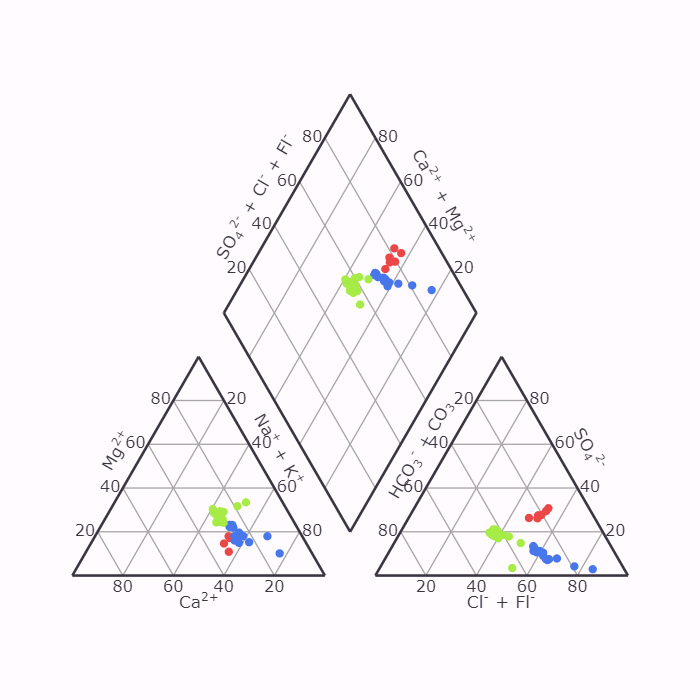Understanding the concept of Durov Diagrams
Durov Diagrams may sound like a complex concept, but they are a simple and effective tool for understanding the relationship between variables. Developed by Russian mathematician Valery Durov, these diagrams can be used to visualize patterns and correlations in data sets. Durov Diagrams’ ability to represent complex relationships clearly and intuitively is what sets them apart from other visualization methods.
The essential components of a Durov Diagram are circles or ovals representing variables, connected by lines or arrows to indicate the relationships between them. The size and position of the circles can also be used to convey additional information about the variables being represented. Different categories or groups within the data set can be distinguished easily using colour coding or shading.
Durov Diagrams offer advantages over other visualization methods, such as scatter plots or bar charts. They provide a holistic view of how multiple variables interact, enabling researchers to uncover hidden trends and patterns that might not be immediately apparent in the raw data. This makes them particularly useful in fields where understanding complex systems is crucial, such as economics, sociology, and ecology. With their simplicity and power to reveal insights, it’s no wonder that Durov Diagrams have become increasingly popular among researchers worldwide.
Definition: What exactly is a Durov Diagram?
A Durov Diagram is a valuable tool in hydrogeochemistry and hydrogeology. It is a graphical representation that allows scientists to understand the chemical composition of groundwater samples collected from different locations. By plotting significant ion concentrations on a triangular graph, the diagram provides insights into the sources and processes that influence water chemistry.
Durov Diagrams’ ability to visually display complex patterns and relationships among numerous variables makes them particularly useful. The triangular shape of the graph enables a straightforward interpretation of data by showing how various ions are distributed relative to one another. This helps researchers identify trends, detect anomalies, and determine the dominant geochemical processes occurring within an aquifer system.
By analyzing a Durov Diagram, hydrogeologists can gain significant insight into groundwater quality, contamination sources, or even changes over time. Moreover, it allows for effective comparison between different sampling sites or periods within one site—a critical aspect in assessing water resource management strategies or investigating potential pollution incidents.
Different regions on the Durov diagram correspond to different hydrochemical characteristics. For instance:
- The centre of the diagram represents relatively fresh water with low ion concentrations.
- The corners of the diagram are associated with water types dominated by a specific ion (e.g., calcium-rich, sodium-rich, sulfate-rich).
- Certain patterns and relationships among points can indicate specific processes like ion exchange or mixing different water sources.
In summary, Durov Diagrams are indispensable tools for those working in hydrogeochemistry and hydrogeology as they visually represent groundwater chemistry patterns. Their triangular shape facilitates the analysis and identification of critical geochemical processes influencing water composition within an aquifer system. By gaining insights from these diagrams, scientists can better understand water quality trends and make informed decisions regarding resource management practices and pollution mitigation efforts.
Historical Background: Origins and Development of Durov Diagrams
The development of Durov Diagrams can be traced back to hydrogeochemistry, which deals with the chemical composition of water and its interaction with rocks. In the early 20th century, Russian scientist Vladimir Durov began studying underground waters and their geochemical properties. He discovered that by plotting the concentrations of major ions in groundwater on a triangular diagram, he could visually represent complex hydrogeological processes.
Durov’s breakthrough in developing these diagrams is recognizing patterns and correlations between different ions. By plotting the concentrations as percentages along the sides of an equilateral triangle, he created a unique graphical representation that allowed for straightforward interpretation and analysis. This innovative approach made it possible to determine water types based on their chemical compositions, leading to significant advancements in understanding aquifer systems.
Over time, researchers worldwide recognized the value of Durov’s diagrams in hydrogeology studies. The diagrams proved particularly useful in identifying different sources and processes contributing to variations in groundwater chemistry. As more data became available and new techniques were developed, Durov Diagrams became indispensable tools for characterizing water quality, modelling contaminant transport, and assessing environmental impacts on freshwater resources.
Today, Durov Diagrams are crucial in hydrogeology and related fields such as environmental science and engineering. Their historical origins are a testament to the power of innovative thinking combined with a deep understanding of geological processes.
Fundamental Components: Exploring the Elements of a Durov Diagram
When it comes to studying hydrogeochemistry and hydrogeology, one helpful tool that researchers often utilize is a Durov Diagram. This diagram visually represents the different geochemical processes occurring in groundwater systems. By plotting concentrations of various elements on the x- and y-axes, important insights can be gained regarding water-rock interactions, mineral dissolution, and other chemical reactions within the aquifer.
The Durov Diagram consists of several vital components crucial for understanding its interpretation. First and foremost, the major elements such as calcium (Ca), magnesium (Mg), sodium (Na), potassium (K), bicarbonate (HCO3-), sulfate (SO42-), and chloride (Cl-) are plotted on the diagram. These elements represent fundamental parameters in assessing groundwater quality and can illuminate ion exchange, weathering reactions, cation exchange capacity, and evaporation effects.
However, more than significant elements are needed to provide a complete picture of hydrogeochemical processes. To gain further insights into redox conditions within an aquifer system, it is necessary to include minor or trace elements in the Durov Diagram analysis. For example, plotting iron concentrations and pH measurements can reveal if an aquifer is influenced by reducing or oxidizing conditions. Additionally, trace metals like arsenic or uranium can be included to assess potential sources of contamination or natural enrichment processes.
Applications: How are Durov Diagrams utilized in various fields?
Durov Diagrams, initially developed for hydrogeochemistry studies, have proven invaluable tools in various fields, including hydrogeology. These diagrams offer a comprehensive way to analyze and interpret water samples’ chemical composition from different sources. In hydrogeochemistry, Durov Diagrams are extensively used to assess groundwater quality by plotting significant ions such as calcium, magnesium, chloride, and sulfate concentrations.
Not limited solely to hydrogeochemistry, Durov Diagrams have also found applications outside this specific field. For instance, these diagrams play a vital role in hydrogeology studies focused on understanding water movement within aquifers and estimating recharge rates. By delineating different zones based on significant ion concentrations using Durov Diagrams, geologists can identify potential areas for contamination or intrusion that could impact overall groundwater quality.
Furthermore, the applications extend beyond the realm of water sciences. Environmental scientists use Durov Diagrams to monitor air quality by analyzing aerosol samples from different locations. Similarly, agricultural scientists utilize these diagrams to gain insights into soil fertility variations across farming regions. Their ability to synthesize complex data into easily interpretable graphical representations providing valuable insights across diverse disciplines, makes Durov Diagrams an indispensable tool for researchers worldwide.
Benefits and Limitations: Pros and cons of using Durov Diagrams
Durov diagrams, commonly used in hydrogeochemistry and hydrogeology, offer several benefits that researchers and scientists find valuable. These diagrams visually represent complex chemical data, allowing for more straightforward interpretation and analysis. By plotting the concentrations of various elements or ions against each other, Durov diagrams enable researchers to identify patterns and relationships between different components within a water sample. This can be particularly useful in determining the origin of water sources or assessing geochemical processes occurring in groundwater systems.
However, despite their usefulness, Durov diagrams also have certain limitations that should be considered. One limit is that they only consider two-dimensional data representations, making it difficult to simultaneously account for variations across multiple parameters. Additionally, Durov diagrams may need to be more balanced with the complexity of hydrogeochemical systems by disregarding essential factors such as pH levels or temporal changes in groundwater quality. Moreover, because these diagrams are based on plotted data points rather than continuous functions, they may not accurately depict subtle variations or gradual changes within a dataset.
In summary, Durov diagrams offer numerous benefits, such as enhanced visualization and identification of patterns within hydrogeochemical data sets. Still, they also have limitations, including a two-dimensional perspective and potential oversimplification of complex systems. Researchers should be aware of these pros and cons when using Durov diagrams to ensure accurate interpretation and analysis in hydrogeochemistry and hydrogeology.
The Durov diagram is an alternative to the Piper diagram, and it plots the major ions as percentages of milliequivalents in two triangles.
What is the difference between a Durov diagram and a Piper diagram?
The Durov diagram and the Piper diagram are used to chart the chemistry of water samples and reveal relationships among them. However, there are some differences between the two diagrams:
- Durov diagram: Plots the major ions as percentages of milliequivalents in two triangles.
- They can be a composite plot based on the percentage of major ion milliequivalents and two optional additional water quality parameters.
- They are an alternative to the Piper diagram.
- Piper diagram: Plots the sample’s relative concentrations of cations and anions.
- Shows the water types with neither anions dominant nor cations dominant.
- Indicates the dominance of mixed water type (70.84%) having no one cation-anion pair exceeds 50%.
Both diagrams help interpret hydrochemical processes in groundwater and can be used to identify water types.

Free GeoChem software provides a comprehensive solution for visualizing geochemical data, including Piper, Schoeller, and Durov formats.
ESdat Geochemistry Graphs provide a comprehensive solution for visualizing geochemical data in milliequivalents per litre. These diagrams encompass widely-used formats, including Piper, Schoeller, Durov, and more.
Lab results automatically received into ESdat, environmental data management system, can be easily filtered and viewed on these graphs. Data can also be uploaded manually from Excel.
The ESdat Freeware Apps are available for everyone to use. However, subscribed ESdat users have the added benefit of centrally managing and analyzing their data, resulting in better data quality and time-saving advantages.
ESdat GeoChem software was released as part of ESdat environmental data management software Version 4.5, released in May 2023, and included:
- Geochem Graphs (incl Piper, Durov and Schoeller) are supported
- GWSDAT Export (which provides Mann-Kendall Trend Analysis)
- Logger Data imports can reduce the data frequency.
- Export EDIFs for just a Monitoring Zone, Site or Project
- Ability to manage users permissions by user groups
- Graphs can export to individual PNG files if needed
- Bulk Co-Scheduling of planned Monitoring Rounds in LSPECS
- Lab Reports can be assigned to Monitoring Rounds on the Lab Report Details screen.
- Notification Settings can be specified per individual user.
Related Articles to Durov Diagrams
How to do Piper Diagrams in Chemistry Water Analysis
Exciting Software Update Unveiled for ESdat Users Worldwide, Elevating Data Management Experience







[…] What are Durov Diagrams? Durov Diagrams What are Schoeller diagrams in geo-chemistry […]
[…] What are Durov Diagrams? […]
[…] What are Durov Diagrams? […]